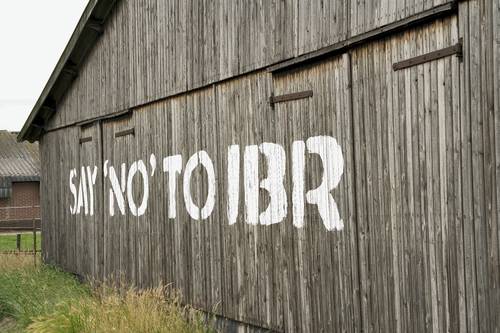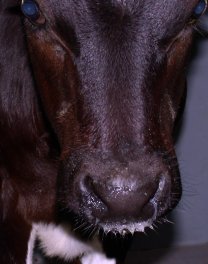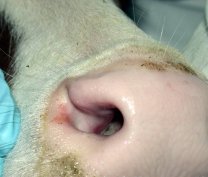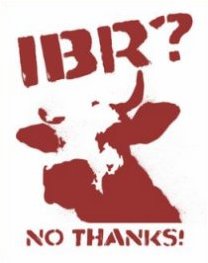
Infectious Bovine Rhinotracheitis (IBR)

Introduction
Infectious bovine rhinotracheitis (IBR) is a disease characterized by acute inflammation of the upper respiratory tract. BoHV-1 infection can also sporadically cause abortion in cattle.
BoHV-1 infection affects animal health and productivity causing significant economic losses to cattle producers. Its main significance is as a barrier to the export of live cattle to other regions or countries within Europe which have already eradicated the disease. It is also a significant disease for pedigree herds placing animals into AI stations. Bulls destined for use in AI are not permitted to have any antibodies to BoHV-1.
Aetiology (Causes)
IBR is caused by bovine herpesvirus 1 (BoHV-1). There are two subtypes of Bovine Herpesvirus 1:
BoHV-1.1
BoHV-1.2
Structural proteins
BoHV-1 is a DNA virus with several structural proteins among which at least 11 transmembrane glycoproteins. Glycoproteins play important roles such as virus-cell interactions and interactions with the immune system. Glycoproteins gB, gD, gH, gK, gL are essential for virus replication, while gC, gG, gI, gE, gM and gN are not essential.
Epidemiology (Factors Influencing Disease Occurrence)
During primary infection, cattle shed virus in high titres in nasal and ocular fluids for approximately 14 days, which can infect in-contact animals.
After replication in the lining of the nose, BoHV-1 is transported along nerves and becomes latent in nerve tissue close to where the virus enters, where it remains during the lifetime of the animal.
Stress or corticosteroid treatment can lead to the reactivation of BoHV-1, which is then transported back along the nerves to the primary infection site. Shedding of reactivated BoHV-1 may or may not be accompanied by clinical signs of the disease. Each animal once infected with BoHV-1 is a lifelong potential shedder of the virus and poses a risk for its BoHV-1 free herd mates.
Direct transmission occurs through contact with:
- Acutely infected animals
- Latently infected animals in which reactivation of the virus takes place
Indirect transmission may occur through:
- Contaminated semen
- Embryo transfer
- Humans
- Contaminated materials
- Airborne transmission

Clinical Signs
BoHV-1 infection in cattle is manifested as upper respiratory tract disease and disease of the reproductive tract.
Clinical signs are influenced by the age of the animal, the dose of virus, route of infection and whether other agents are also present.
Signs relating to Respiratory Disease
Infectious Bovine Rhinotracheitis (IBR)
Fever (as high as 42 C)
Depression
Loss of appetite
Reddening of the mucous membranes
Ulceration / reddening of the upper airway
Nasal discharge – Initially watery and later may become purulent
Conjunctivitis – runny eyes
Drop in milk production
Signs relating to Reproductive Disease
Abortion
Infectious pustular vulvovaginitis (IPV)
Initially oedema of the lining of the vulva and vagina is seen. Pustules then form which often coalesce, giving rise to a yellowish-white membrane. Lesions usually heal within 10-14 days, in some animals a purulent discharge may persist.
Infectious pustular balanoposthitis (IPB)
The prepuce may be swollen and a mucopurulent discharge may be seen. Often lesions are only obvious on extrusion of the penis. Some bulls lose their libido and find erection and ejaculation painful.

Diagnosis
Clinical signs of IBR are indicative of BoHV-1 infection but laboratory tests are required for a definitive diagnosis. Often respiratory disease in cattle is caused by multiple concurrent viral and bacterial infections (e.g. Pasteurella multocida, Mannheimia haemolytica etc). Laboratory tests are required for a specific viral diagnosis.
Blood sampling for antibody levels
Virus neutralization
Retrospective diagnosis of BoHV-1 infection can be made by measuring antibody levels in paired sera samples. First sample is collected during the clinical phase and a second sample is collected 4 weeks later.
ELISA
There are two types of BoHV-1 ELISA tests currently available for evaluating antibody levels. The use of marker vaccines is important in the differentiation of infected and vaccinated animals. Whole virus antibody ELISAs cannot differentiate between animals that were exposed to vaccine or field virus. gB ELISAs become positive approximately 3 weeks after exposure to either vaccine or field virus. gE ELISAs become positive approximately 4 weeks after exposure to field virus or non-marker vaccines. They do not become positive after exposure to marker vaccine. Thus using antibody testing can allow the differentiation of animals that were only exposed to marker vaccine from those that were exposed to either field virus or non-marker vaccine.
Post-mortem Examination
IBR infection is rarely fatal unless complicated by secondary infection. Congestion of the tracheal lining with small haemorrhages are often found. Inflammation does not usually extend into airways contained within the lung.

Control
Control of IBR is based on four equally important aspects:
- Selective culling – Reduction of circulating virus can be achieved with the introduction of a vaccination program and progressive culling of those animals that are identified as a potential source of the virus. In farms with a very low sero-prevalence (proportion that are positive on an antibody test) culling without vaccination can be an option. However in most farms due to the high sero-prevalence it is not economically feasible to test and cull all the sero-positive animals.
- Biosecurity – Maintaining biosecurity involves avoiding introduction of infected animals into the herd and/or implementing stict isolation / quarantine of introductions until proven negative, and restricting access of livestock to external sources of infection e.g. double fencing is in place at all perimeters, considering carefully sources of biological materials such as embryos, semen etc.
- Vaccination – The use of live vaccines is preferred above the inactivated ones because of the superior efficacy in clinical protection and more importantly in reduction of the virus circulation in newly infected animals. MSD Animal health market live (Bovilis IBR Marker Live) and inactivated (Bovilis IBR Marker Inac) vaccines. Further product specific information on Bovilis IBR Marker Live or on Bovilis IBR Marker Inac may be obtained by clicking on the relevant product of interest for your region under the product list tab on the MSD Animal Health homepage. Bovilis IBR Marker Live can now conveniently be mixed with Bovilis BVD and given on the same day for booster vaccination. To view a video demonstrating how to mix the vaccines please click here.
- Monitoring – This varies depending on the nature and risk status of your herd. Appropriate screening programmes can be discussed with your local veterinary practitioner.
Further information on the National control programme and IBR is available on the Animal Health Ireland website.
